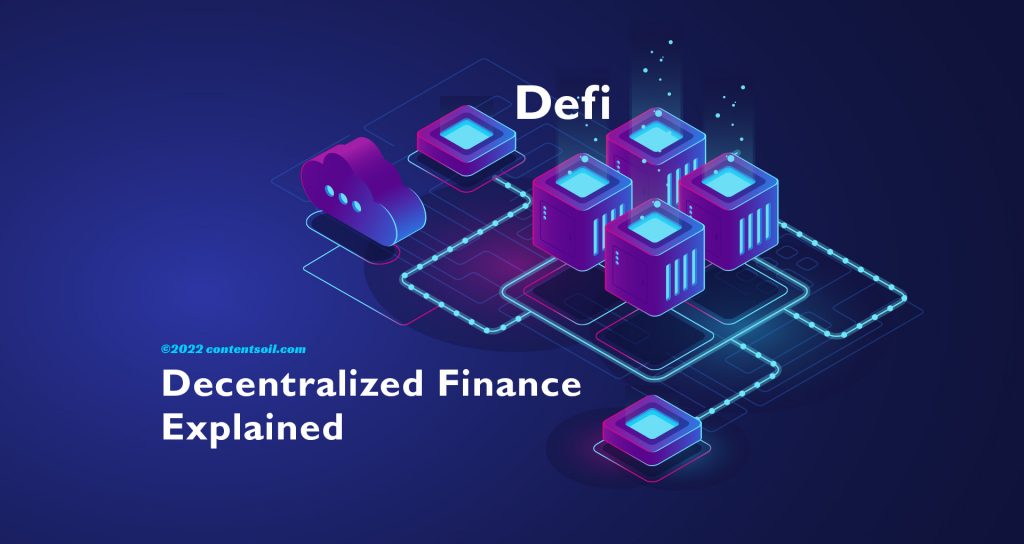Using distributed ledgers like those used by cryptocurrencies, Decentralized finance is an emerging financial technology. There is no longer a need for banks and other financial institutions to control money, financial products, and financial services.
Defi has a number of appealing features for users, including:
- Banks and other financial institutions can no longer levy fees for using their services.
- You don’t put your money in a bank; instead, you store it digitally in a safe place.
- A web connection is required for access without approval from a supervisor.
- Transferring money takes only a few seconds or minutes nowadays.
Without the involvement of third parties, financial transactions can now be conducted, thanks to Defi, a form of decentralized finance.
Stablecoins, software, and hardware are the building blocks of Defi, which may be used to build apps.
Regulation and infrastructure for Defi are currently being developed and debated.
Decentralized Finance:
Defi varies from centralized finance in several key ways necessary to grasp to appreciate how it operates fully.
Centralized Finance:
Banks and other financial entities hold your money in centralized finance, whose primary objective is to profit from your savings. In the financial system, numerous third parties enable money transfers between parties, each collecting a charge for doing so. Suppose, for example, that you use your credit card to buy a gallon of milk. Credit card networks receive the information from the acquiring bank, which passes it to the merchant.
The network contacts your bank to collect payment for the cleared charge. The charge is approved by your bank, which then sends a confirmation to the network, the acquiring bank, and the merchant. Each business in the chain is compensated for its services because retailers must pay for your ability to use credit and debit cards.
In contrast to other financial activities that cost money, loans can take days to be granted; You might not be able to access a bank’s services while you’re on vacation.
Decentralized Finance:
Through cutting-edge technology, individuals, small businesses, and large corporations can conduct financial transactions directly with one another, cutting out the middlemen altogether. To secure the security of transactions, peer-to-peer financial networks use security protocols, connectivity, software, and hardware advances.
Using software that records and verifies financial transactions in distributed financial databases, you can lend, trade, and borrow from any place with an internet connection. All users’ data is collected and aggregated through a distributed database, which relies on a consensus method to ensure its accuracy.
Anyone can now access financial services, regardless of their identity or location, through the use of this technology.
How does Defi Work?
Blockchain technology is used in decentralized finance, just like cryptocurrencies. Using a blockchain, you can create a secure and distributed database. DApps or distributed applications run transactions and the blockchain.
Blocks are used to store transactions on the blockchain that are subsequently cross-verified by other members of the network. In this situation, the block is closed and encrypted, and a new block is created that contains the information from the previous block.
The term “blockchain” applies to the fact that each block is linked to the one before it by the information it contains. There is no way to edit a blockchain since any changes to prior blocks would impact subsequent ones. This and other security standards bolster a blockchain’s security.
Defi Financial Products:
Defi is founded on the concept of P2P financial transactions. An example of a P2P Defi transaction is when two parties agree to exchange cryptocurrencies for products or services, but a third party must be involved.
Consider the process of obtaining a loan in centralized finance in order to grasp this properly. Your bank or another lender would require an application for one. Your interest and service charges would accrue if the lender of your choice accepted your application.
Using a dApp, you would enter your loan requirements, and an algorithm would match you up with other borrowers that fit your criteria. To get your money, you’d have to agree to one of the lender’s terms.
After the consensus mechanism verifies the transaction in the blockchain, you will receive your loan. Finally, you can start making the agreed-upon repayments to your loan provider. There are several ways to make a payment on your dApp, and they all go through a similar chain of events.
Defi Currency:
Defi is a cryptocurrency-based payment system. Since the technology is constantly evolving, it’s difficult to say whether existing cryptocurrencies will be implemented. Stakeholder-backed stable coins, such as the dollar-pegged stable coin USDT, are central to the concept.
The future of Defi:
Still in its infancy, the growth of decentralized finance. Unregulated systems are rife with infrastructure errors, hacks, and schemes.
The current laws were designed on the concept of several financial jurisdictions, each with its own set of laws and rules. The potential of Defi to conduct borderless transactions raises important issues for this form of regulation. For instance, who is responsible for investigating a financial crime across borders, protocols, and Defi apps? How would the rules be enforced, and by whom?
System stability, energy usage, and carbon footprint all need to be considered.
Prior to classifying Defi as safe, various issues must be addressed. There will be ways for banks and enterprises to get into the system, if not to control how you use your money, then to profit from the system if Defi succeeds.” One of the most important sources of revenue for financial institutions will not be squandered.


